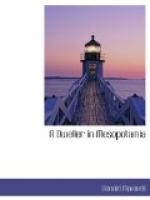The sergeant could not speak Hindustani and the pilot could not speak a word of English. Mistakes of the most frantic nature were common, especially when we were being whirled round and round by the stream at a difficult corner. In the midst of controversy unrelieved by any glimmer of understanding on the part of anybody present we would slide gracefully into a state of rest on a mudbank or bump violently against the shore. Luckily, it seemed as easy to get off the mudbank as to get on it, and we finally got into positions we wanted to for making sketches of various points. The pantomimic violence of the sergeant, together with diagrams in my sketch-book, were ultimately successful.
[Illustration: A BEND IN “THE NARROWS” OF THE TIGRIS]
Nearly all the Tigris steamers proceeding up river have loaded lighters on each side of them. These act as fenders at the corners and take the bump whenever the bank is encountered. The progress is slow and there is often a good deal of waiting, for in the region between Ezra’s tomb (above Kurna) and Amara there is not room for two steamers thus encumbered to pass with safety. These waters are known as the Narrows. Signal stations are placed at various intervals, and a signal is made to clear the way, generally for the down-river boat, the up-river craft, which, with the stream against them, will not have to turn round in stopping, tying up to the bank. This manoeuvre is done in a few minutes. The steamer that is to stop runs alongside the bank and natives with stakes jump out and drive them into the marsh ground. She moors to these until the other vessel has passed downwards.
The sketch facing page 30 was done from a steamer bound up-river, which had tied up under these conditions. The paddler coming down has a lighter on each side of her as the one sketched on page 38. She will come down toward the leading marks shown on the right-hand side of the picture, and then slide along the bank, using the lighter on the port side as a fender. Then she will leave the bank and shoot across to the other side of the river, taking the next turn with her starboard lighter.
This drawing will serve to show the general nature of most Mesopotamian river scenery, dead flat, with nothing or little to relieve the monotony, a great expanse of muddy waters and featureless dust, with just a suggestion in one direction of a low line of blue—very faint. It tells of the far-away Persian mountains and of snow.
The great feature of the Narrows, however, and one which all our dwellers in Mesopotamia will remember vividly as long as they live, is the egg-sellers from the Marsh Arab villages on the banks. Although a steamer proceeding up-river may be kicking up a great fuss in the water and apparently thumping along at a great rate, it is, in reality, making only about four knots on the land. Consequently, when it sidles into the bank, with one of its lighters touching the marsh, the natives who are selling things can keep up, and a running—literally running—fire of bargaining is maintained between the ship’s company and the Arabs.




